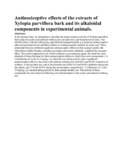| dc.description.abstract | In the present study, we attempted to elucidate the antinociceptive activity of Xylopia parviflora bark using the acetic acid-induced writhing test, hot plate test, and formalin test in mice. The MeOH extract (100 and 200 mg/kg, administered intraperitoneally (i.p.)) had an antinociceptive effect demonstrated by its inhibitory effects on writhing number induced by acetic acid. Three alkaloidal fractions exhibited significant antinociceptive effects in three animal models; the chloroform-soluble fraction, including secondary and tertiary alkaloids, exhibited the strongest effect. This result supported its use in folk medicine as an analgesic agent. We tested the main alkaloids of these fractions for their antinociceptive effects to clarify the active components. (+)-Corytuberine (6.3 and 12.5 mg/kg, i.p.) showed very strong activity, had a significant antinociceptive effect in the acetic acid-induced writhing test (with 49.4 and 98.9% reduction of writhes), in the hot plate test, and in the formalin test (with 55.4 and 90.6% inhibition during the first phase, and 73.9 and 99.9% during the second phase, respectively). (+)-Glaucine (12.5 and 25 mg/kg, i.p.) showed strong activity in three animal models, too. The activity of these compounds was also observed following oral administration in the acetic acid-induced writhing test. | en |

